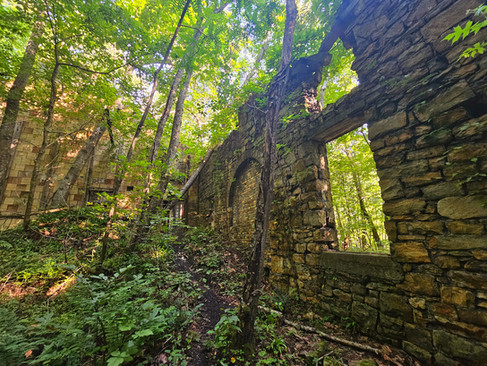Stairway to History: Hiking the Kaymoor Miners Trail in New River Gorge
- Dan Wagner
- Jul 26
- 6 min read
Updated: Jul 31
Hiking the Kaymoor Miners Trail in New River Gorge is a short but intense plunge into both natural beauty and industrial history. The trail begins with a steep, rocky descent through a lush Appalachian forest before reaching the top of an epic wooden staircase—over 800 steps—that leads deep into the gorge. Along the way, the trail passes remnants of the Kaymoor One coal mining operation, including ruins of old buildings and rusted machinery overtaken by moss and vines. At the bottom, you're rewarded with views of the New River and a hauntingly quiet mining complex that once buzzed with life. The hike back up is a test of endurance, but it’s a uniquely immersive journey into West Virginia’s rugged past.


Trailhead elevation 1,969'
Water none
Don't miss exploring the ruins
Hiking the Kaymoor Miners Trail
After an early morning at Endless Wall to catch sunrise, I grab breakfast and head out to the Kaymoor Miners Trail—one of the few hikes in the gorge I’ve yet to cross off my list. It’s already a scorching 88 degrees at 9:00 a.m., and I know the climb back up will be brutal. I chug some water, leave the parking area, and make my way to the trailhead.

Here, I pick up a few new details about the mine that build on what I’ve already learned through my own research. In 1873, Abiel Abbot Low—managing director of the Low Moor Iron Company in Low Moor, Virginia—purchased the property. It remained untouched until 1899, when the mine was finally opened to provide coal and coke for the company’s blast furnaces. Two towns were established to house workers and their families: Kaymoor Top on the rim of the gorge and Kaymoor Bottom down by the New River. More on that later.
The trail kicks off with a mix of rocky path and short wooden stair switchbacks. It's rarely level but not yet punishing, and I start to wonder when the infamous 800-plus step staircase will show up.

At 0.6 miles in, I arrive at the Sewell bench and the iconic steel I-beam sign that reads, “Your family wants you to work safely.” A century ago, coal miners rode a mountain haulage rail—angled at a steep 30% grade—from Kaymoor Top down 500 feet to this very spot to begin their long, grueling shifts.

Just below, the 821-step staircase looms—but before I descend, I take time to explore what remains of the bench-level structures. To the left, the old cinderblock lamp house, where miners stored their lamps, and superintendent’s office—both built in the 1950s—stand in quiet decay.

Nearby, a faded safety board once tracked the mine’s accident-free streak. During Kaymoor's 62 years of operation (1899–1962), 21 miners lost their lives, mostly due to cave-ins, electrocutions, and fire. Some deaths were especially gruesome: Tonney Harris, run over by a train in 1907; Amos Howell (age 18) and Elmer Butler (age 25), killed when a cable snapped from the mountain haulage, sending them plummeting 70 feet over a cliff in 1913; H.M. Taylor, struck in the head by a runaway iron wheel in 1915; and Louis Rombaut (age 22), skull crushed against a roof in 1922. And sadly, the list goes on.

Beside the safety sign is a sealed mine entrance once used by miners to access horizontal shafts deep underground. A rusted mine car still rests on its original tracks out front.

To the right sits the powder house, once used to store black powder, dynamite, and fuses. Its heavy steel door with a circular vent still hangs in place, a testament to the craftsmanship of the time.

Before continuing down, I glance across the gorge and realize I’m staring directly at Endless Wall and Diamond Point, where I’d stood earlier that morning. It's a really great view and I pause for a moment to take it all in.

Then, I begin my descent. About halfway down, I pass the old cap house, used to store blasting caps for detonation.

Just beyond it, a rusted 20-foot-tall steel water tank—used to collect water from inside the mine—rests on its concrete pad.

Beneath the staircase, visible nearly the entire way down, are the old I-beam tracks of the mountain haulage system that once ferried men and materials up and down the slope.

At the bottom, I reach Kaymoor’s ruins: the remains of the once-bustling coal processing plant and power station.


The buildings are crumbling, held together by little more than rust and memory.

Yet back in its heyday, Kaymoor was one of the most productive mines in New River Gorge. Its first shipment—58,900 pounds of coal—left the site on August 23, 1900. That year alone, it produced over 64,000 long tons. Over 62 years, it cranked out more than 16.9 million tons of coal—enough to fill 18 Empire State Buildings from top to bottom, and processed one million tons of coke to fuel blast furnaces.


To support such a massive operation in such a remote location, the Low Moor Iron Company constructed two company towns: Kaymoor Bottom along the New River and Kaymoor Top on the rim of the gorge. Both townsites were named after James Kay, a Low Moor Iron Company employee responsible for overseeing its construction. Between 1901 and 1905, 112 houses were built along the river for workers and their families. By 1923, the combined population of Kaymoor Top and Bottom reached 560, with 140 people employed directly by the mine. Below is a photo of Kaymoor Bottom, courtesy of the NPS.

These were true company towns, with the Low Moor Iron Company not only providing housing but also constructing schools, churches, company stores, a theater, and even tennis courts. Kaymoor Top was developed later, between 1918 and 1919, with around 20 homes built to accommodate employees working the upper sections of the mine and the incline railway.

This infrastructure served both to support daily life and to keep workers closely tied to the company. And by tied to the company, I mean tied. Miners at Kaymoor were paid in company-issued currency known as scrip, which could only be used at company-owned stores. Outside the confines of Kaymoor, this scrip held no value, effectively trapping workers within the company’s economic system. According to a 1904 company report, the average miner earned $36 per month. Rent for housing in Kaymoor Top or Kaymoor Bottom cost $5 per month for an unfurnished home, or $8 per month for a furnished one. 78 homes had electricity for an additional $2 per month and only 25 had running water.
Food and household goods were also purchased at inflated prices using scrip. For example, a 24-pound sack of flour cost $0.75, bacon was $0.20 per pound, coffee sold for $0.30 per pound, molasses was $0.40 per pound, potatoes were $0.30 for a one-pound sack, and a dozen eggs went for $0.20. These prices were often nearly double what the same goods cost outside of Kaymoor, but because miners were paid in scrip, they had little choice but to buy from the company store.

As demand for coal declined and mining operations began to slow, the town's population dwindled. By 1952, Kaymoor Bottom had been abandoned, and in 1960, most of its remaining structures were destroyed in a fire. At its peak, the mine employed over 800 men—many of them immigrants or African Americans seeking new opportunities. But by the 1940s, the coal seam began to give out, and after WWII, demand waned. Cars made it easier for miners to commute, and the once-thriving town around the mine began to fade. By 1961, production had dropped to just 10,515 tons. A year later, it was all over.

Sixty-three years later, I've found that hiking the Kaymoor Miners Trail is more than just a scenic and physically demanding trek—it's a powerful window into the past. As I descended the steep, rocky path and navigated the 821 steps down to the remnants of the old mine, I couldn’t help but reflect on the lives of the men and families who once called this place home. Standing among the rusted machinery, crumbling foundations, and abandoned rail tracks, I gained a deeper appreciation for the sheer grit and sacrifice it took to make a living in the coal mines. The trail doesn’t just tell a story—it makes you feel it.
_edited.png)

















































